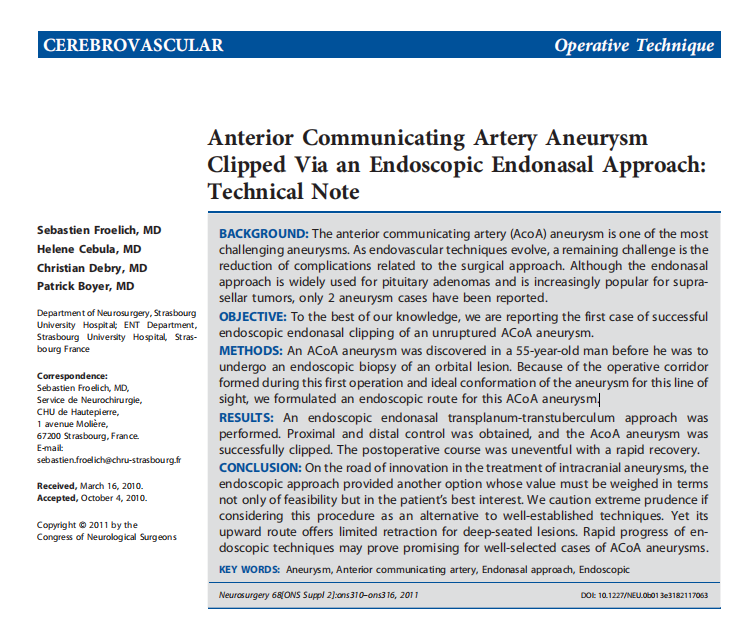Anterior Communicating Artery Aneurysm Clipped Via an Endoscopic Endonasal Approach:Technical Note
英文摘要:
BACKGROUND: The anterior communicating artery (AcoA) aneurysm is one of the most challenging aneurysms. As endovascular techniques evolve, a remaining challenge is the reduction of complications related to the surgical approach. Although the endonasal approach is widely used for pituitary adenomas and is increasingly popular for supra sellar tumors, only 2 aneurysm cases have been reported.
OBJECTIVE: To the best of our knowledge, we are reporting the first case of successful endoscopic endonasal clipping of an unruptured ACoA aneurysm.
METHODS: An ACoA aneurysm was discovered in a 55-year-old man before he was to undergo an endoscopic biopsy of an orbital lesion. Because of the operative corridor formed during this first operation and ideal conformation of the aneurysm for this line of sight, we formulated an endoscopic route for this ACoA aneurysm.
RESULTS: An endoscopic endonasal transplanum-transtuberculum approach was performed. Proximal and distal control was obtained, and the AcoA aneurysm was successfully clipped. The postoperative course was uneventful with a rapid recovery.
CONCLUSION: On the road of innovation in the treatment of intracranial aneurysms, the endoscopic approach provided another option whose value must be weighed in terms not only of feasibility but in the patient’s best interest. We caution extreme prudence if considering this procedure as an alternative to well-established techniques. Yet its upward route offers limited retraction for deep-seated lesions. Rapid progress of endoscopic techniques may prove promising for well-selected cases of ACoA aneurysms.
中文摘要:

BACKGROUND: The anterior communicating artery (AcoA) aneurysm is one of the most challenging aneurysms. As endovascular techniques evolve, a remaining challenge is the reduction of complications related to the surgical approach. Although the endonasal approach is widely used for pituitary adenomas and is increasingly popular for supra sellar tumors, only 2 aneurysm cases have been reported.
OBJECTIVE: To the best of our knowledge, we are reporting the first case of successful endoscopic endonasal clipping of an unruptured ACoA aneurysm.
METHODS: An ACoA aneurysm was discovered in a 55-year-old man before he was to undergo an endoscopic biopsy of an orbital lesion. Because of the operative corridor formed during this first operation and ideal conformation of the aneurysm for this line of sight, we formulated an endoscopic route for this ACoA aneurysm.
RESULTS: An endoscopic endonasal transplanum-transtuberculum approach was performed. Proximal and distal control was obtained, and the AcoA aneurysm was successfully clipped. The postoperative course was uneventful with a rapid recovery.
CONCLUSION: On the road of innovation in the treatment of intracranial aneurysms, the endoscopic approach provided another option whose value must be weighed in terms not only of feasibility but in the patient’s best interest. We caution extreme prudence if considering this procedure as an alternative to well-established techniques. Yet its upward route offers limited retraction for deep-seated lesions. Rapid progress of endoscopic techniques may prove promising for well-selected cases of ACoA aneurysms.
中文摘要:
背景:前交通动脉动脉瘤是较具挑战性的动脉瘤之一。随着血管内技术的发展,剩下的挑战是减少与手术方法相关的并发症。尽管经鼻入路广泛应用于垂体腺瘤,且越来越多地应用于鞍上肿瘤,但有2例动脉瘤病例报道。
目的:据我们所知,我们报告的一例成功的内镜下腔内夹闭未破裂的ACoA动脉瘤。
方法:一名55岁男子在接受眼眶病变的内镜活检前发现ACoA动脉瘤。由于一开始手术形成的手术路径和这条视线理想的动脉瘤构象,我们制定了ACoA动脉瘤的内镜路径。
结果:采用经鼻内镜下经鼻咽鼓管入路。获得近端和远端对照,成功夹闭AcoA动脉瘤。术后过程平稳,恢复迅速。
结论:在颅内动脉瘤治疗的创新道路上,内镜入路提供了另一种选择,其价值不仅要从可行性上考虑,而且要从患者的较大利益上考虑。如果我们认为这一程序是一种成熟技术的替代方案,我们要谨慎行事。然而,它的上行路径为深部病变提供了有限的收缩。快速发展的内镜技术可能被证明是有希望的精心选择的ACoA动脉瘤的病例。





